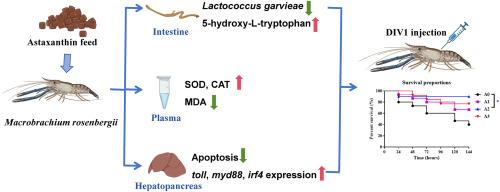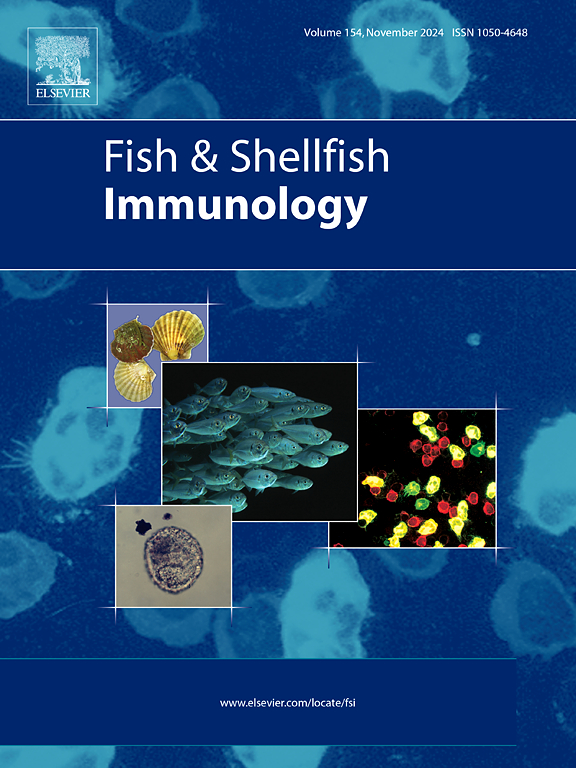饲料中添加虾青素对罗氏沼虾肠道菌群和代谢物、抗氧化能力及对虹彩十足病毒1型抗性的影响
IF 3.9
2区 农林科学
Q1 FISHERIES
引用次数: 0
摘要
众多病原微生物的出现和跨界传播严重阻碍了对虾养殖业的可持续发展。营养调节被认为是提高水生动物抗病能力的关键策略。本试验旨在研究饲料中添加虾青素对罗氏沼虾生长性能、肠道菌群及代谢产物、抗氧化能力、免疫反应及对彩虹十足病毒1 (DIV1)抗性的影响。方法分别在对虾饲料中添加0、100、500、1000 mg/kg剂量的虾青素,试验8周后进行DIV1攻毒试验。通过分析累积存活率、肠道菌群和代谢物、血浆抗氧化指标、肝胰脏组织学和免疫相关基因表达水平来评估其效果。结果大鼠小肠和肝胰脏虾青素水平显著升高(P < 0.05)。饲料中虾青素组显著降低了鸡乳球菌的相对丰度,显著提高了5-羟基- l -色氨酸水平(P < 0.05)。在DIV1攻毒试验后,500 mg/kg虾青素组的累积存活率显著提高(P < 0.05)。各组饲料中虾青素显著提高了血浆SOD和CAT活性(P < 0.05)。饲料中添加虾青素可显著降低血浆MDA水平和肝胰腺细胞凋亡率(P < 0.05)。虾青素添加组toll、myd88和irf4基因的相对表达量显著升高(P < 0.05)。饲料中添加虾青素对对虾的生长性能影响不显著。结论饲料中虾青素可改善肠道菌群和代谢产物,增强抗氧化能力,增强myd88依赖性toll -信号通路,防御DIV1。总的来说,建议在饲料中添加500 mg/kg虾青素以达到罗氏沼虾的最佳健康效益。本文章由计算机程序翻译,如有差异,请以英文原文为准。

The effects of dietary astaxanthin on the intestinal microbiota and metabolites, antioxidant capacity, and resistance to Decapod iridescent virus 1 in Macrobrachium rosenbergii
Background
The appearance and cross-border dissemination of numerous pathogenic microorganisms have substantially hindered the sustainable growth of the prawn's farming industry. Nutritional regulation is considered a key strategy for improving disease resistance in aquatic animals.
Aims
A feeding trial was conducted to evaluate the effects of dietary astaxanthin on growth performance, intestinal microbiota and metabolites, antioxidant capacity, immune response, and resistance to decapod iridescent virus 1 (DIV1) in Macrobrachium rosenbergii.
Methods
Dietary supplementation with astaxanthin at doses of 0, 100 mg/kg, 500 mg/kg, and 1000 mg/kg was administered to prawns for 8 weeks, followed by a DIV1 challenge test. The effects were evaluated by analyzing the cumulative survival rate, intestinal microbiota and metabolites, plasma antioxidant indices, hepatopancreatic histology, and the expression levels of immune-related genes.
Results
The levels of astaxanthin were significantly increased in the intestine and hepatopancreas (P < 0.05). The relative abundance of Lactococcus garvieae decreased and 5-hydroxy-L-tryptophan level significantly increased in dietary astaxanthin groups (P < 0.05). Following the DIV1 challenge test, the cumulative survival rate was significantly increased in 500 mg/kg dietary astaxanthin group (P < 0.05). Plasma SOD and CAT activities were significantly increased in dietary astaxanthin groups (P < 0.05). Plasma MDA levels and apoptosis rate in hepatopancreas were significantly reduced in dietary astaxanthin groups (P < 0.05). The relative expression levels of toll, myd88, and irf4 genes were significantly increased in astaxanthin supplemented groups (P < 0.05). Dietary astaxanthin did not significantly affect the growth performance of prawns.
Conclusion
Dietary astaxanthin has the potential to improve intestinal microbiota and metabolites, enhance antioxidant capacity, and strengthen MyD88-dependent Toll-signaling pathways for defense against DIV1. Overall, 500 mg/kg dietary astaxanthin was recommended to achieve the optimal health benefits for M. rosenbergii.
求助全文
通过发布文献求助,成功后即可免费获取论文全文。
去求助
来源期刊

Fish & shellfish immunology
农林科学-海洋与淡水生物学
CiteScore
7.50
自引率
19.10%
发文量
750
审稿时长
68 days
期刊介绍:
Fish and Shellfish Immunology rapidly publishes high-quality, peer-refereed contributions in the expanding fields of fish and shellfish immunology. It presents studies on the basic mechanisms of both the specific and non-specific defense systems, the cells, tissues, and humoral factors involved, their dependence on environmental and intrinsic factors, response to pathogens, response to vaccination, and applied studies on the development of specific vaccines for use in the aquaculture industry.
 求助内容:
求助内容: 应助结果提醒方式:
应助结果提醒方式:


